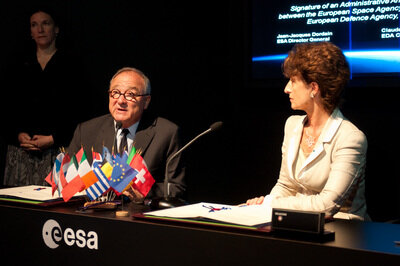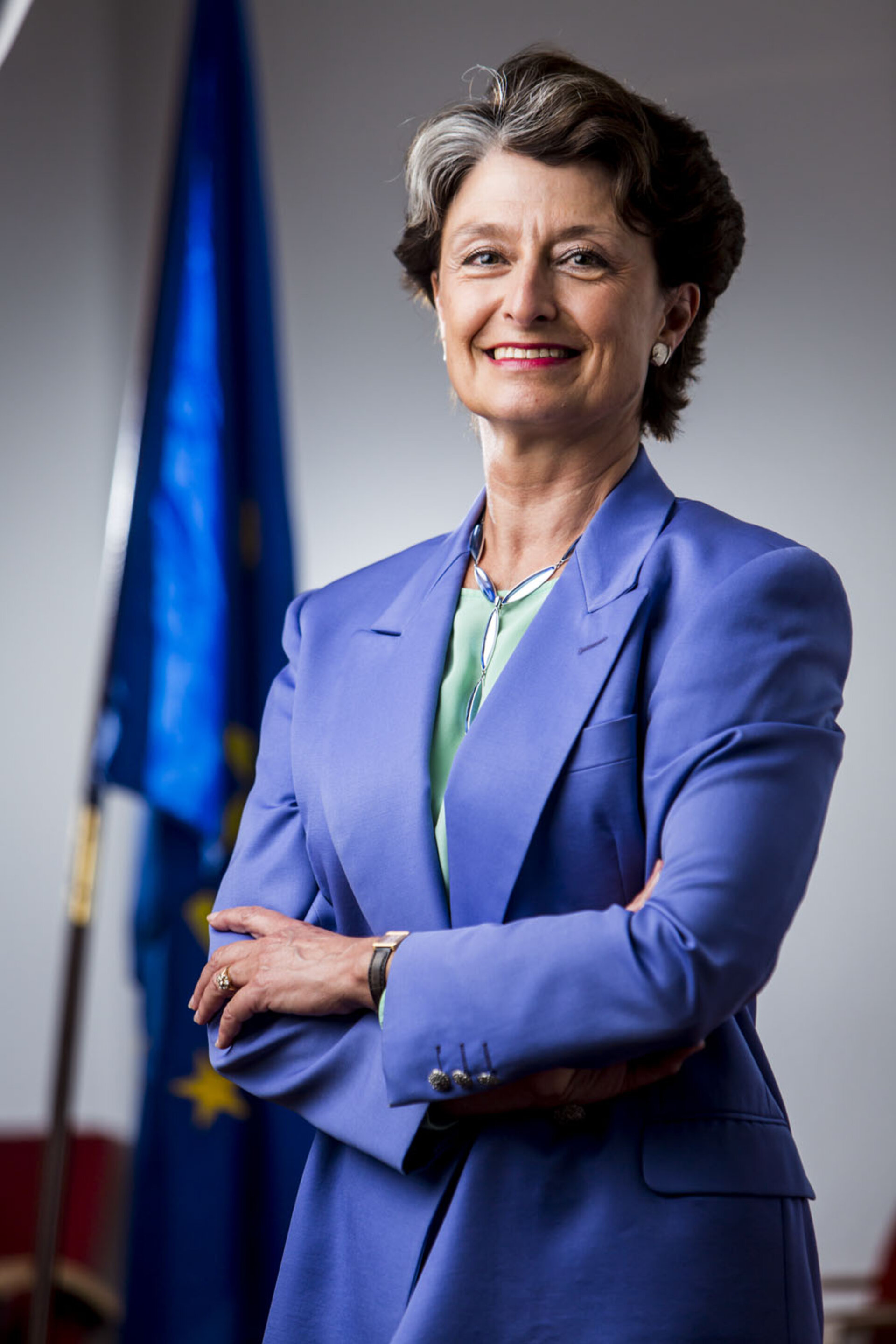Claude-France Arnould, Chief Executive of the European Defence Agency: ‘Space is now embedded in practically everything we do’
Claude-France Arnould, Chief Executive of the European Defence Agency met Jean-Jacques Dordain, ESA Director General, at ESTEC on 9 July to discuss their respective activities and their cooperation on space and security.
This visit was also an opportunity to hold an interview with EDA’s Chief Executive, outlining key items on the ESA–EDA cooperation agenda.
Following the signing of the 2011 Administrative Arrangement, ESA–EDA cooperation has now matured to new levels. How is space relevant to Europe’s Common Security and Defence Policy and EDA’s activities?
EDA’s role is to develop, for its Member States, key defence capabilities necessary both for decision-making and operations. Developing the right tools to act is our core mandate. Space is an obvious part of this objective as it has become a vital element of any security or military action. Space allows independent information, enabling Europeans to make the right decisions at the right time. It also allows for increased operational efficiency. It is relevant for individual Member States as well as for action under the CSDP.
My message is simple: we cannot do better with less
Space has gradually been the focus of increased attention within the EU. The European Space Policy was instrumental in raising awareness, as well as ESA–EU Member States positions expressed through various Space Councils.
Today, we are committed to pursuing this policy drive in the context of the European Council of December 2013, where Heads of States and Governments will address defence. The April 2013 Steering Board of EDA, composed of participating Member State Ministers of Defence, already paved the way towards this end, namely in the area of satellite communications.
Regarding the European Council under preparation, how is EDA preparing for this unprecedented event, and what will be the scope of its contribution?
Preparing a European Council involves many actors and large-scale policy and programmatic preparations. The final responsibility lies with the President of the EU, Herman van Rompuy. Contributions will come from the report of Cathy Ashton, based on EDA and EEAS contributions. There will be a communication from the Commission, and no doubt Member States will also contribute. My message is simple: we cannot do better with less. Public investments in research and development are essential today. I believe the rationale for space is the same: not only are our programmes a direct benefit to the European economy, they also lead Europe to further build its comparative advantage vis-à-vis its competitors through cutting-edge innovation and technology. It ensures strategic autonomy.
Space is now embedded in practically everything we do, in our everyday lives, but also in security operations
More specifically, I am proposing that we remain concrete: the European Council’s successful outcome will require hands-on and concrete proposals. This is the reason why EDA is contributing with ambitious capacity packages in such areas as air-to-air refuelling, remotely piloted aircraft systems (RPAS), cyber defence or space.
As you’ve just mentioned, one of EDA’s main tasks is to prepare tomorrow’s defence capabilities in Europe. Which particular space-related workstrands are of direct interest to the military communities?
Space is now embedded in practically everything we do, in our everyday lives, but also in security operations, from intelligence gathering to flying a drone. Like ESA, we are an intergovernmental agency. Our Member States are therefore the first beneficiaries of our programmes, but also the sole decision-makers. They are expressing support for exploring future capability packages in governmental satellite communications, which I believe would greatly benefit from a civil-military approach with ESA and Member States alike, building on the extraordinary experience of ESA.
We are currently engaging our Member States in order to do so, to make sure our proposals fit with their interests. In parallel, ESA and EDA will be looking at the best way to synchronise to make sure we reap the most benefits from civ-mil synergies for our respective activities and mandates.

A second workstrand is RPAS. In this regard, the successful DESIRE demonstration, an ESA–EDA cooperation demonstrating the ability to use satellite communications to pilot a UAV in general air traffic, which took place on 24 April, is a very solid project. We are looking into expanding our activities in this regard with DESIRE II, which we’re also undertaking in collaboration with ESA’s Integrated Applications Programme.
Finally, cyber defence has been gaining a lot of momentum. Space is one of the critical components of our ability to decide and act, and cyber security needs to incorporate to the space segment of our capabilities. ESA and EDA are also cooperating on this crucial item.
But everything is not about projects. It begins with common requirements from the military users. Space being dual use by nature, we bring to the table the right people to express the needs of the military community. This could be in the area of satellite navigation and positioning, for example. Another item is how EDA can learn from ESA’s experience in building innovative programme structures or business models, building new partnerships with industry for instance. Alphasat in this respect could bring a wealth of ideas and lessons supporting EDA’s future initiatives.
You have mentioned Europe’s current budgetary strains. How does EDA foresee its support to the defence industry?
This is a crucial point. ESA–EDA cooperation does not solely reside in exploiting synergies in technology development. With the cooperation on Critical Technologies for non-dependence, we have already shown that we are good and efficient at this. I believe that ESA and EDA share many policy drivers, constraints and opportunities, support to industry being one.
I was happy that Jean-Jacques Dordain invited me to attend the 2012 ESA Council at Ministerial level in Naples, where I witnessed first-hand Member States putting Europe’s industrial competitiveness on top of their agenda through space.
Similarly in defence, the crisis has hit us very hard. We estimate that from 2007 to 2011, defence R&D expenditure decreased by more than 18% and R&T by more than 20%, while 75% of equipment procurement by value is still conducted on a national basis. Yet, we believe that public defence investments have a 1.6 multiplier effect on the economy. In the UK alone, even, every single euro invested generates a return of €2.3. Defence represents 750 000 direct and indirect jobs across Europe and a turnover of €170 billion.
This means that European actors, such as EDA and ESA, who share similar concerns and industrial players, have a significant responsibility in supporting competitiveness and growth, and drawing this necessary bridge between public investments and job creation. This is a task that we also seek to discuss together soon. But again, we need programmes.





